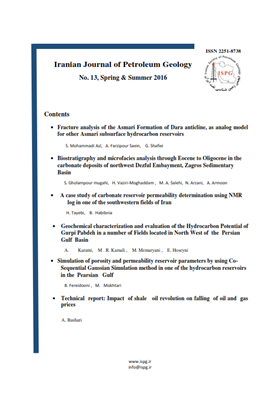Simulation of porosity and permeability reservoir parameters by using Co-Sequential Gaussian Simulation method in one of the oil field in the South West of Iran
Subject Areas : PetrophysicsBahareh Fereidooni 1 , Mohammad Mokhtari 2 *
1 -
2 -
Keywords: Effective porosity Permeability Co-Sequential Gaussian Simulation Validation,
Abstract :
Three-dimensional study of petrophysical parameters of hydrocarbon reservoirs such as porosity and permeability is considered as an efficient and effective tool for comprehensive study of reservoirs as well as reservoir management. In this study, which was carried out on one of the oil fields in the southwest of Iran, the aim is to simulate the petrophysical parameters of effective porosity and permeability by using Co-Sequential Gaussian Simulation in part of Khatiyah reservoir. With this simulation, a three-dimensional model of petrophysical reservoir parameters can be presented which is important for simulating fluid flow and identifying areas that are prone with higher reservoir quality. For this purpose, effective porosity and permeability logs of seven wells with 3D seismic data and seismic inversion results have been used. After reservoir gridding and creating a structural model, up scaled petrophysical data has entered to model and its own cell. For three-dimensional distribution of effective porosity parameter, due to the correlation of effective porosity and acoustic impedance attribute of seismic inversion, 3D seismic data and up scaled effective porosity logs as the initial data and acoustic impedance attribute of seismic inversion as secondary data have entered in Sequential Gaussian Simulation. In order to simulate permeability, due to the good correlation between effective porosity simulation model and permeability log, simulated porosity as a secondary data and up scaled permeability and 3D seismic data as secondary data have been used. The results of validation indicate the accuracy of the present study and the efficiency of Sequential Gaussian Simulation method in effective porosity and permeability modeling in this reservoir.
[1]امیدوار، آ.، کمالی، م. ر. و کاظم زاده، ع. ا.، 1392، شبیه سازی سه بعدی استاتیکی و تخمین پارامترهای مخزنی با به کارگیری روش های زمین آماری در یکی از مخازن ایران: پژوهش نفت، سال بیست و سوم، شماره 75، صفحه 57-49. #
[2]حسنی پاک، ع، 1389، زمین¬آمار (ژئواستاتیستیک)، انتشارات دانشگاه تهران، 314 صفحه.#
[3]خواجه، م. م. و آقابیگی، م.، 1387، تخمین و شبیه سازی توزیع فضایی تراوایی یکی از مخازن جنوب ایران با استفاده از روش های زمین آماری، ماهنامه اکتشاف و تولید، شماره 53، ص 59-62.#
[4]رندو جی. ام، 1371، اصول زمین آماری، ترجمه مهندس علی اصغر خدایاری، انتشارات جهاد دانشگاهی دانشکده فنی تهران.#
[5]شعبانی، ف.، 1387، مدل سازی سه بعدی مخزن آسماری میدان نفتی شادگان با استفاده از نرم افزار IRAPRMS، پایان نامه کارشناسی ارشد، دانشگاه شهید چمران اهواز، 116 صفحه. #
[6]شعبانی، ف.، بشیری، غ.، کرامتی، م. و ایزدخواه، م.، 1390، شبیه سازی پارامترهای پتروفیزیکی مخازن هیدروکربنی با استفاده از روش SGS در یکی از میادین جنوب غربی ایران، پژوهش نفت، سال بیست و یکم، شماره 66، ص 53-66.#
[7]مطیعی، ه.، 1372، زمین شناسی ایران، چینه شناسی زاگرس، انتشارات سازمان زمین شناسی کشور، 536 صفحه.#
[8]#Dean L., 2007, Reservoir Engineering for Geologists, Part3-Volumetric Estimation, Reservoir Issue11, pp. 20.
Deutsch C. V. and Journel A. G., 1992, GSLIB: Geostatical Software Library and user’s guide, Oxford University Press, New York, 340 P[9].#
Deutsch C. V. and Cockerman P. W.,1994, Geostatistical Modeling of Permeability with Annealing Co-simulation (ACS): SPE28413[10].#
Goovaerts, P., 1997, Geostatistics for Natural Resources Evaluation; Oxford University Press: New York, pp. 512[11].#
Robinson A., Griffiths P., 2008, The Future of Geological Modeling in Hydrocarbon Development. Geological Society, 2th Ed[13].#
Soleimani, B., Shabani, F., AmirBakhtiar, H., Haghparast, G., 2008, Fault effect at volumetric modeling in Shadegan[14]#

